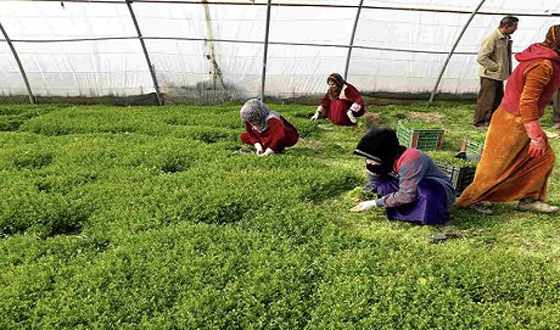The Kurdistan Regional Government’s (KRG) Ministry of Agriculture recently reported a surge in greenhouse produce cultivation in winter season due to increasing demand for fresh greens and the economic crisis which has plagued the region for more than two years now.
Greenhouse farming is a recent trend in the Kurdistan Region. It emerged in the winter of 2008 after a group of Kurdish agricultural engineers experimented glasshouse farming. The results were promising; hence, they encouraged local farmers to grow produce in greenhouses. Nowadays, demand for fresh greens surpasses the amount which local greenhouses produce. That is why, farmers import fresh vegetables in the Iraqi town of Najaf to meet the demands of market.
“Temperatures in the Kurdistan Region fall from October to February. Vegetables like cucumbers, tomatoes, aubergines, and peppers cannot withstand the cold conditions under greenhouses. And it is costly to put a heating system in these glasshouses, which is why we asked farmers not to leave these greenhouses vacant during these months, instead grow parsley, spinach and broccoli,” Kamal Mohammed, director of greenhouse farming in Kurdistan Region’s ministry of agriculture, said.
He added that local farmers initially were not as fascinated about the idea of greenhouse farming in the region. They have, however, embraced the trend over the past two years as a financial crisis continues to make living conditions difficult for people.
“This year, more than 2,500 greenhouses have had produce cultivated in them. And this number is increasing gradually,” Mohammed added. According to figures produced by the Kurdish ministry of agriculture and water resources, there were only 224 glasshouses in 2007 in the Kurdistan Region. These houses were given to local farmers to use for free.
Nowadays, there companies are vying to build greenhouses in the Kurdistan Region following a surge in interest in them by farmers. The number of greenhouses reached nearly 13,000 last year, with 65-perecent of them built in the province of Sulaimani.
“Because of reduced wages and the financial crisis, many farmers from the province of Sulaimani have turned to cultivating produce in greenhouses. According to preliminary figures, this year, more than 2,000 glasshouses have been used to grow vegetables like parsley, fresh onions, spinach, radish and other green leafs,” Mala Kamil Dawd, head of the Association of the Greenhouse Development, said.
In the past, some farmers were using sewage water to irrigate their vegetables, dirty water which was feared that might cause diseases. Hence, the ministry of health prohibited vegetables at restaurants in an attempt to prevent the spread of diseases.
Sherko Luqman, who is a farmer from the village of Allaye in the town of Bazian near Sulaimani, has used 65 glasshouses to grow produce this year. “Cultivating green leafs in greenhouses is very successful. Its products are also better than the products of farming in the open air.”
He sends nearly 7,000 bunches of green leafs to the market on a daily-basis. “This year, in the province of Sulaimani, many farmers have cultivated produce in greenhouses. Hence, our products are not easily sold there. We therefore export our products to Erbil, Dohuk, Akre, Zakho, Kalar and Penjwen.”
“In the past, we were renting a greenhouse for 250,000 Iraqi Dinars in the winter. Nowadays, owners of glasshouses use their glasshouses to cultivate produce themselves due to increasing demand for green leafs. That is why it is difficult to find a greenhouse for rent nowadays,” Luqman added.
Greenhouse farming is also proving popular in the region’s capital of Erbil, too.
“This year, more than 500 greenhouses have been used to cultivate produce in Erbil. But their products do not meet the demands of the market in Erbil due to increasing demand and the increasing number of population as a result of taking in refugees,” Mohammed detailed.
Kaifi Ismail Bapir, a shop owner in Erbil, noted that produce deliveries from southern Iraq supplement demand in Erbil.
“There is a big demand for vegetables in Erbil, and local products cannot meet the market’s high demands. Businessmen import seven lorries of vegetables from Najaf, with each lorry containing 35,000 bunches of green leafs. This is aside from the vegetables we get from Sulaimani,” Bapir added nothing that the price of most vegetables would double or triple without them.
Rudaw
7 February










































































